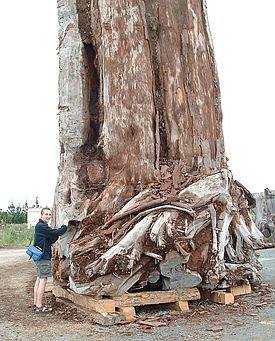With help of the spectacular find of 256 subfossil* stumps in Zurich in 2013, a team at the Swiss Federal Research Institute WSL and ETH Zurich aims to extend the currently available 12,500-year-old by another 1,500 or even 2,000 years. This absolutely dated tree-ring chronology is used worldwide for calibrating radiocarbon dates. Colleagues in New Zealand have pursued the same goal with ancient Kauri wood. Both teams met earlier this month at WSL to join forces.
Two years after being discovered in Zurich by tree-ring specialists of the Swiss Federal Institute for Forest, Snow and Landscape Research WSL, the remains of the largest Late Ice Age forest ever found in Europe still create suspense. In collaboration with partners from ETH Zurich, Germany’s Research Centre for Geosciences in Potsdam (GFZ), the City of Zurich’s Building Department, the University of Freiburg in Breisgau, and the University of Heidelberg, WSL scientists are keen to date the 256 stumps to the exact calendar year using the scientific method called dendrochronology.
The oldest absolutely dated tree-ring chronology so far, which is mainly based on oaks from Germany and pines from Switzerland, reaches back to around 12,500 years BP**. The stakes are high and go well beyond tree-ring research: this chronology is the "gold standard", which is indispensable for helping to improve the accuracy of radiocarbon dates widely used in archaeological and palaeoenvironmental research (see box on radiocarbon calibration).
The Zurich subfossil wood holds very promising hopes, as preliminary dating suggests that it may extend the existing chronology by another 1,500 or even 2,000 years back into late-glacial times.
Collaboration around the world
Scientific endeavours at WSL have met an unexpected ally – astonishingly as far away from Zurich as conceivable. In New Zealand, ancient kauri (Agathis australis) trees have been perfectly preserved in bogs over the last 50,000 years and beyond. Because of its extensive age-range, subfossil kauri is worldwide a unique scientific resource, which has already been used for reconstructing past ocean circulation patterns as well as regional and global climate change.
Ulf Büntgen, head of the Dendroecology Group at WSL, and Jonathan Palmer from the University of New South Wales in Sydney, expect, firstly, to significantly augment both the chronology of the Swiss pines and that of the New Zealand counterpart by crossdating, i.e. comparing them to each other. The resulting chronologies will then be added to the existing 12,500-year chronology, with the ultimate purpose of improving radiocarbon dates.
Radiocarbon dating is applied when a preliminary age estimate is necessary for old organic material such as pottery, bones or paper – and ancient wood. Once tree-ring scientists manage to date their samples to the exact year, they return radiocarbon experts the favour: truly known-age material as essential to improve the accuracy of radiocarbon dating. This so-called calibration of radiocarbon dating with help of tree-ring chronologies has been an international collective effort, coordinated for several decades by the IntCal working group.
Exploitation of subfossil kauri wood
The collaboration between the teams in Switzerland and New Zealand was sealed precisely during an IntCal workshop hosted last month by WSL and ETH. For the first time, scientists from both disciplines – tree-ring and radiocarbon – and from both hemispheres discussed common opportunities and challenges.
Another direct outcome of this meeting was a letter to Nathan Guy, Primary Industries Minister of New Zealand, expressing the participants’ concern for the loss of subfossil kauri, some of it up to 225,000 years old. While the Zurich subfossil stumps have been carefully salvaged and are stored for future scientific investigation, hundreds of their counterparts from New Zealand are being shipped to Asia and Europe to be crafted into furniture – and lost forever to science.
Intensified collaboration between scientists from Switzerland and New Zealand in addition to large capacity in the new WSL storage facility – a former military bunker – might provide a unique opportunity to preserve the cultural and natural treasure of the ancient New Zealand kauri forests.
* Subfossil = any prehistoric organism which has not fossilized, or only partially. Unlike fossils, subfossils can be dated using the C14 method (source: Wikipedia).
** BP = Before Present: a time-scale that is used in archaeology, geology and other sciences to date events in the past. Since ‘the present’ is constantly changing, international consensus was reached on making 1 January 1950 or the calendar year 1950 the point of reference (source: Wikipedia).
Radiocarbon dating (also referred to as carbon or carbon-14 dating) is a method for determining the age of organic material by using the properties of radiocarbon (14C), a naturally occurring radioactive isotope of carbon, which is constantly being formed in the atmosphere by the interaction of cosmic rays with nitrogen. During its life, a plant or animal exchanges carbon with its environment, so the carbon it contains will have the same proportion of 14C as the atmosphere. Once it dies, it ceases to acquire 14C, but the 14C stored in its biological material at that time will continue to decay, and so the proportion of 14C in its remains will gradually decrease. Because 14C decays at a known rate, the proportion of 14C can be used to determine how long it has been since a given sample stopped exchanging carbon. However, this basic principle is complicated by significant variations of the level of 14C in the atmosphere over time. Radiocarbon dates thus have to be corrected via reliable data from other, known-age sources – the most accurate of which being absolutely dated tree rings. This correction process is known as radiocarbon calibration. (Adapted from Wikipedia) |
Links
- Swamp Monsters – the Looting of Northland’s Sunken Assets (19 June 2015)
Contacts
Contact
- Dr. Lukas Wacker
ETH Zurich, Laboratory of Ion Beam Physics
Tel. +41 44 633 2358
wacker (at) phys.ethz.ch - Dr. Jonathan Palmer
University of New South Wales, Sydney
Tel. +61 2 9385 9766
j.palmer (at) unsw.edu.au
